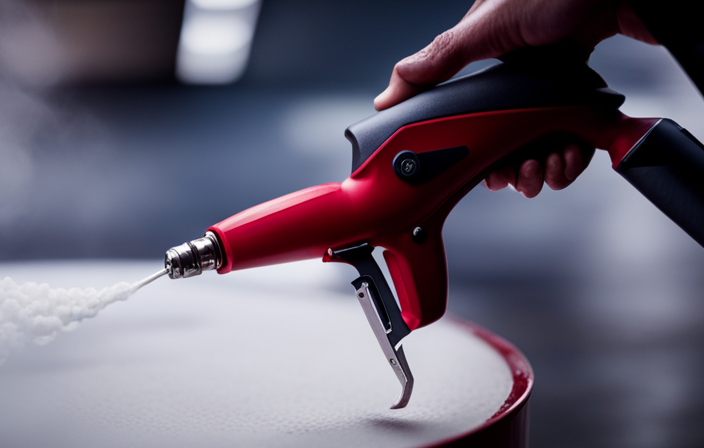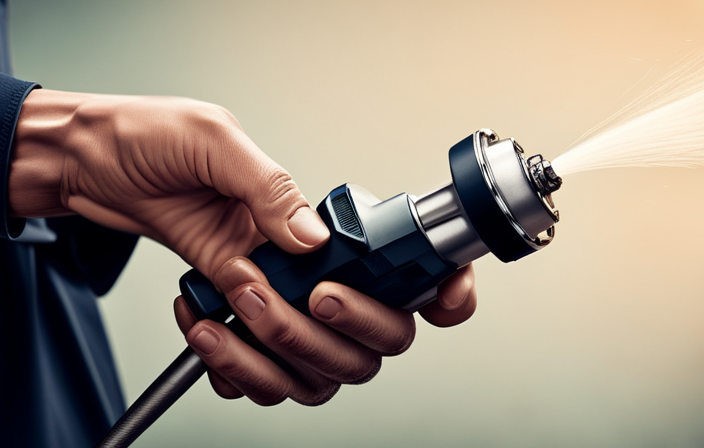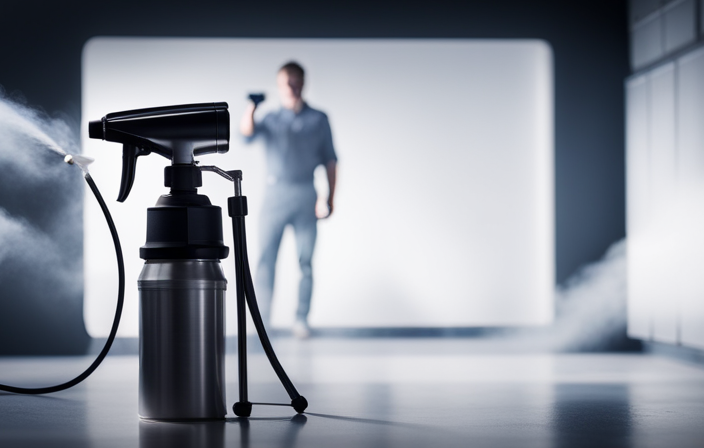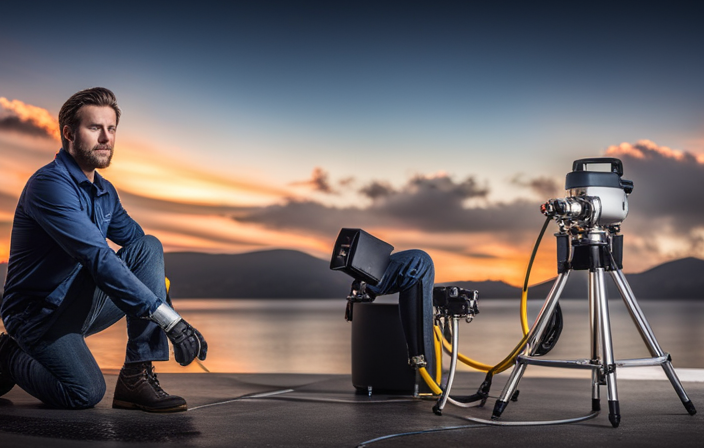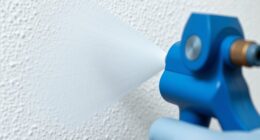Choosing the correct paint is essential when using an airless paint sprayer, as it can greatly affect the final result.
Picture this: you’ve invested in a high-quality sprayer, you’re ready to tackle that painting project, but if you don’t choose the right paint, you might end up in a sticky situation. Trust me, I’ve been there. That’s why it’s crucial to understand the importance of paint selection.
You need to consider factors like viscosity, compatibility with your sprayer, coverage, drying time, and even the environmental impact. It’s not just about slapping any old paint on the walls; it’s about achieving a flawless finish that lasts. Plus, let’s not forget about the cost and availability of the paint.
So, in this article, I’ll guide you through the process of choosing the perfect paint for your airless sprayer, so you can achieve professional results every time.
Key Takeaways
- The type of paint you use with an airless sprayer can affect its performance and durability.
- Consider the cost and availability of the paint, while also prioritizing budget-friendly options without compromising quality.
- Choose a paint brand that is readily available in your area and known for its longevity and resistance to wear and tear.
- Take into account the environmental impact of the paint, opting for eco-friendly options with low VOCs and made from renewable resources.
Understand the Importance of Paint Selection
You need to understand the importance of paint selection because using the wrong type of paint with your airless sprayer could result in a disastrous and frustrating painting experience.
When using an airless sprayer, there are two key factors to consider: viscosity considerations and paint compatibility with the sprayer. Viscosity refers to the thickness or consistency of the paint. If the paint is too thick, it may clog the sprayer nozzle, leading to uneven coverage or even damage to the sprayer. On the other hand, if the paint is too thin, it may result in overspray or drips.
Additionally, it is crucial to ensure that the paint you choose is compatible with your airless sprayer. Some sprayers may require specific types of paint, so it’s important to check the manufacturer’s recommendations.
Considering the viscosity of the paint is essential for achieving a smooth and professional finish with your airless sprayer.
Consider the Viscosity of the Paint
When using an airless sprayer, it’s important to consider the thickness of the paint, resembling the consistency of maple syrup flowing smoothly through the machine. The viscosity measurement of paint refers to its resistance to flow. It is crucial to choose a paint with the right viscosity for your airless sprayer to ensure optimal performance.
Here are three factors to keep in mind regarding paint consistency:
-
Proper spraying: Paint that is too thick can clog the sprayer nozzle, leading to uneven application and potential damage to the machine. On the other hand, paint that is too thin may result in overspray and a lack of coverage.
-
Adjusting viscosity: Different paints require different levels of viscosity. Some paints may need thinning with water or a specific thinner to achieve the desired consistency for spraying. It’s important to follow the manufacturer’s instructions for proper paint thinning.
-
Test and adjust: Before painting a large area, it’s advisable to conduct a test spray on a small surface to ensure the paint is flowing smoothly and evenly. If needed, make adjustments to the viscosity until the desired results are achieved.
Considering the viscosity of the paint is just one step in the process of using an airless sprayer effectively. The next section will delve into choosing the right paint type for your project, providing further guidance for successful painting outcomes.
Choose the Right Paint Type for Your Project
When choosing the right paint type for your project, it’s important to consider whether you should use oil-based or water-based paints.
Oil-based paints are known for their durability and are commonly used for exterior projects.
On the other hand, water-based paints are easier to clean up and are commonly used for interior projects.
Understanding the differences between these two types of paints can help ensure the success of your painting project.
Oil-based vs. Water-based Paints
Using an airless sprayer, go for oil-based paints if you want a durable finish, or opt for water-based paints if you prefer easier clean-up and a quicker drying time.
Oil-based paints are known for their exceptional durability, making them ideal for high-traffic areas or surfaces that require frequent cleaning, such as kitchen cabinets or furniture. They also provide a smooth and glossy finish, enhancing the overall appearance of your project.
On the other hand, water-based paints are easier to work with and offer a faster drying time. They’re also less likely to yellow over time, making them a great choice for interior walls and ceilings.
When using an airless sprayer, it’s important to consider the paint’s durability and application techniques.
Transitioning into the next section, let’s now discuss the differences between exterior and interior paints.
Exterior vs. Interior Paints
Exterior and interior paints have distinct characteristics that can greatly impact the aesthetics and longevity of your home.
When it comes to exterior paint durability, it’s essential to choose a paint that can withstand the harsh elements, such as sunlight, rain, and temperature fluctuations. Exterior paints are specifically formulated to be more resistant to fading, cracking, and peeling.
On the other hand, interior paints offer a wide range of color options to suit your personal taste and style. From vibrant hues to subtle neutrals, you have the freedom to create the perfect atmosphere inside your home.
Now that we understand the differences between exterior and interior paints, it’s crucial to check the paint’s compatibility with your sprayer. This ensures smooth application and optimal results for your painting project.
Check the Paint’s Compatibility with Your Sprayer
Contrary to popular belief, the type of paint you opt for actually makes a world of difference when working with an airless sprayer. It’s important to check the paint’s compatibility with your sprayer to ensure smooth operation and avoid any potential damage. Here are a few key factors to consider:
-
Paint compatibility: Different airless sprayers have different requirements when it comes to the type of paint they can handle. Some may work best with latex paints, while others may require oil-based paints. It’s essential to choose a paint that’s recommended for use with your specific sprayer model.
-
Sprayer maintenance: Certain paints can be more prone to clogging or causing wear and tear on your sprayer’s components. By selecting a paint that’s compatible with your sprayer, you can minimize the risk of clogs and reduce the need for frequent maintenance.
-
Ease of cleaning: Opting for a paint that’s easy to clean from your sprayer can save you time and effort. Look for paints that are labeled as ‘easy to clean’ or ‘easy to flush’ to make the cleanup process hassle-free.
Considering the coverage and drying time of the paint, it’s essential to choose a type that suits your project’s needs.
Consider the Coverage and Drying Time of the Paint
When selecting paint for your project, it’s crucial to take into account the coverage and drying time to ensure a successful and efficient outcome.
Coverage considerations play a significant role in determining how many coats of paint will be needed to achieve the desired finish. Different paints have varying levels of opacity, so it’s essential to choose one that provides adequate coverage for your specific project. Additionally, factors such as the type of surface being painted and the texture of the paint can also affect coverage.
Drying time is another important factor to consider. Some paints dry quickly, allowing for faster completion of the project, while others may require longer drying times, which can prolong the overall timeline.
By carefully considering the coverage and drying time factors, you can select the paint that best suits your project’s needs. This will ensure a smooth transition into evaluating the paint’s performance and durability.
Evaluate the Paint’s Performance and Durability
Once you’ve selected the perfect paint for your project, it’s time to evaluate how well it performs and its durability.
To evaluate the paint’s performance, it’s important to consider the paint finish. Take a close look at the final result after the paint has dried. Does it have a smooth and even finish, or are there streaks and imperfections? A high-quality paint should provide a flawless finish that enhances the appearance of your project.
Additionally, it’s essential to compare paint brands. Some brands may offer better performance and durability than others, so it’s worth doing some research and reading reviews. By evaluating the paint finish and comparing paint brands, you can ensure that you are using a high-quality paint that will deliver long-lasting results.
Moving forward, it’s also important to take into account the environmental impact of the paint.
Take into Account the Environmental Impact of the Paint
Consider the environmental impact of the paint you choose and how it can contribute to a greener and more sustainable future. When using an airless sprayer, it’s important to take into account the environmental regulations surrounding paint products.
Many traditional paints contain harmful chemicals that can be released into the air during the spraying process. These chemicals can have negative effects on human health and contribute to air pollution. To mitigate these issues, it’s recommended to look for sustainable alternatives that comply with environmental regulations.
There are now eco-friendly paints available in the market that are low in volatile organic compounds (VOCs) and are made from renewable resources. By opting for these sustainable paints, you can reduce the environmental impact of your painting projects.
Now, let’s consider the cost and availability of the paint.
Consider the Cost and Availability of the Paint
To ensure you make a well-informed decision, it’s crucial to take into account the affordability and accessibility of the paint you choose for your project. When considering the cost and availability of the paint, keep in mind the following:
-
Budget-friendly options: Look for paints that offer cost effectiveness without compromising on quality. There are many affordable options available that still provide excellent coverage and durability.
-
Local availability: Consider the convenience of purchasing the paint. Opt for brands that are readily available in your area, as this’ll save you time and effort in sourcing the paint.
-
Durability and longevity: Choose a paint that’s known for its longevity and resistance to wear and tear. This’ll ensure that your project stays looking fresh and vibrant for years to come.
When you’ve considered the cost effectiveness and paint quality, it’s important to follow proper preparation and application techniques to achieve the best results.
Follow Proper Preparation and Application Techniques
It’s essential to ensure proper preparation and application techniques are followed in order to achieve the best results when using an airless sprayer. One of the key aspects to consider is proper surface preparation. Before using the sprayer, it’s important to clean and prime the surface to ensure proper adhesion of the paint. This may involve sanding, cleaning, and repairing any damaged areas.
Additionally, it’s crucial to follow the manufacturer’s guidelines for the paint application. This includes maintaining the correct pressure, distance, and speed while spraying. By using the proper application techniques, you can ensure an even and professional-looking finish.
As we transition into the subsequent section about maintaining and cleaning your airless sprayer properly, it’s important to note that these steps will help prolong the life of your sprayer and ensure its optimal performance.
Maintain and Clean Your Airless Sprayer Properly
Proper maintenance and cleaning are crucial to keep my airless sprayer performing at its best and to extend its lifespan. By following a few simple steps, I can ensure that my sprayer stays in top shape.
Firstly, I need to clean the sprayer thoroughly after each use. This involves flushing it with the appropriate cleaning solution and running it until the water runs clear.
Secondly, I should inspect the spray tip regularly and replace it if necessary. A clogged or worn-out tip can affect the quality of the paint job.
Additionally, I need to check the filters and clean or replace them as needed.
Lastly, troubleshooting tips can come in handy if any issues arise.
By following these proper maintenance practices, I can ensure that my airless sprayer continues to deliver excellent results.
Frequently Asked Questions
Can I use any type of paint with an airless sprayer?
You can use different types of paint with an airless sprayer, but it’s important to consider the pros and cons. Some paints may require thinning or special additives, while others may not provide the same level of finish.
Does the type of paint affect the performance of the airless sprayer?
The type of paint does affect the airless sprayer’s performance. Paint viscosity determines how well it sprays, while paint coverage determines how evenly it coats surfaces. It’s important to choose the right paint for optimal results.
What happens if I use a paint that is not compatible with my sprayer?
Using a paint that is not compatible with your airless sprayer can have a negative impact on its performance. It may clog the nozzle, result in uneven spray patterns, or cause the sprayer to malfunction altogether.
Is it necessary to consider the drying time of the paint when using an airless sprayer?
Considering the drying time of paint is crucial when using an airless sprayer. It ensures proper application and prevents issues like clogging or uneven coverage. Additionally, paint compatibility with the sprayer is essential for optimal performance and results.
Are there any environmental concerns related to the type of paint used with an airless sprayer?
When using an airless sprayer, it is important to consider the environmental impact of the paint used. Different types of paint can release harmful chemicals into the air, affecting air quality.
Conclusion
In conclusion, choosing the right type of paint for your airless sprayer is crucial for achieving the best results. Just like selecting the perfect ingredients for a recipe, using the right paint can make all the difference in the outcome of your project.
It’s like using high-quality, fresh ingredients in cooking – they enhance the flavor and presentation of the dish. Similarly, using the appropriate paint ensures smooth application, even coverage, and a long-lasting finish.
So, don’t underestimate the importance of paint selection when using an airless sprayer.

